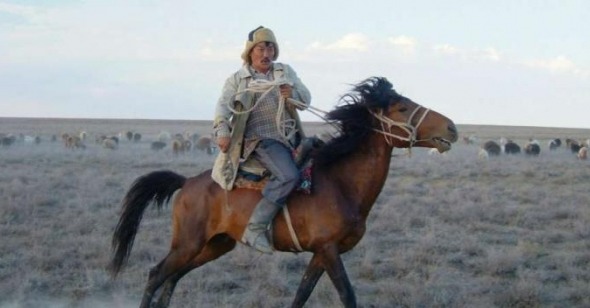Frontiersman
By Leo Goldsmith
Tulpan
Dir. Sergei Dvortsevoy, Kazakhstan, Zeitgeist Films
Though the word remains untranslated in the film's English subtitles, Tulpan—the title of Sergei Dvortsevoy's first dramatic feature—means "tulip." It is also, of course, the name of the object of protagonist Asa’s desire, a beloved glimpsed only once, through the slats of a goat-pen (and not at all by the viewer). "God, is she beautiful!" exclaims Asa, a former sailor who dreams of being a shepherd with a flock, family, and yurt of his own on the vast flatlands of the Betpak-Dala (also known as the Hunger Steppe) of southern-central Kazakhstan. No tulip will grow here, so Asa scratches a crude drawing of one into the dry earth of the steppe, and later, with a ballpoint pen, he draws one on the underside of the collar of his sailor's uniform, where he has similarly depicted all the things he longs for.
Dreams and aspirations linger below the dusty surface of Tulpan, and each of its characters expresses a secret desire for something that seems to lie just beyond the arid landscape's distant horizon. While his gold-toothed friend Boni blasts Boney M's version of "Rivers of Babylon" from his porn-plastered tractor, dreaming of large-breasted women and the kind of luxurious urban living he sees in magazine ads, Asa aspires to a life beyond his brother-in-law Ondas's tent, where he must live as a subordinate shepherd. For Asa, this life is particularly oppressive—no less so than life in the Navy, probably—with Ondas treating him little better than his children, who dutifully recite for him the news they've memorized from the radio while begrudgingly squeezing the blackheads on his enormous back. Though he boastfully spins tales of naval courage in the face of octopus and other exotic sea creatures, Asa offers Tulpan's family only a meager dowry: ten sheep and a chintzy plastic chandelier (which seems rather useless in a yurt). But Tulpan has her own ideas, at first rejecting Asa for his big ears (to which Boni's picture of Prince Charles proves no counterargument), and then in favor of a life in the city and a college education. For her, the steppe holds no future, and while Asa is sensitive to these aspirations (he whispers his own dreams through the crack in the goat-pen door, with no discernible response), he's also acutely aware of the immediate difficulties of real life, those everyday obstacles that are his family's livelihood.
Such is the balance that Dvortsevoy strikes in Tulpan between the elusive ephemera of desire and the harsh immediacy of rural life. Mainly known for four short observational documentaries, the director captures the world of the Betpak-Dala in astonishing natural and ethnographic detail in his first fiction film, making what initially seems to be a place of unvaried flatness into a surprisingly dynamic setting, with camels, sheep, and brush dotting the landscape and dust clouds swelling in grey-yellow-lavender skies. In more than one astonishing long take—either the product of masterful blocking and animal-wrangling or of miraculous serendipity—the camera takes in a marvelous confluence of elements in a single 360-degree sweep, wandering amongst a dozen adults, children, sheep, donkeys, and dogs in the foreground, with lightning and storm-clouds on the horizon.
With this harsh and beautiful backdrop so attentively rendered, at once otherworldly and palpable, the desires of Tulpan's characters become almost metaphysical imperatives. Asa's hopes for a better existence—not just for a yurt equipped with satellite television but also for a family and livelihood—are part of an increasingly desperate effort for the continuation of a way of life, if not life itself. A mysterious pox begins to afflict Ondas's flock, killing pregnant ewes and causing calves to be stillborn, and Dvortsevoy's narrative employs this affliction as a way of portraying this fight for cultural survival symbolically, but not thunderously so. There are two animal births onscreen—the first a suspenseful set piece, the second an utterly harrowing single-take tour-de-force—and each serves to ground the characters' musings, their hopes, and their individual concerns in a world with real stakes and discernible consequence. Asa's desires are understandable, perhaps very like our own, but Dvortsevoy's film measures the distance between such hopes and the necessities of living. By patiently portraying this environment, as well as sensitively mining its protagonists' inner worlds, Tulpan commands the spectator's attention and sympathy. After 100 minutes with Dvortsevoy's film, one feels that one has lived with these characters for weeks, and that the demands and aspirations of their lives are not so very far from one's own.
